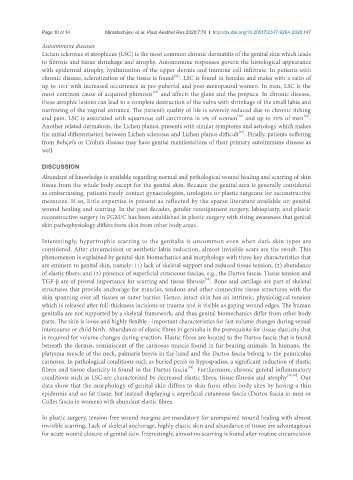Page 834 - Read Online
P. 834
Page 10 of 14 Mirastschijski et al. Plast Aesthet Res 2020;7:70 I http://dx.doi.org/10.20517/2347-9264.2020.147
Autoimmune diseases
Lichen sclerosus et atrophicus (LSC) is the most common chronic dermatitis of the genital skin which leads
to fibrosis and tissue shrinkage and atrophy. Autoimmune responses govern the histological appearance
with epidermal atrophy, hyalinization of the upper dermis and immune cell infiltrate. In patients with
[24]
chronic disease, sclerotization of the tissue is found . LSC is found in females and males with a ratio of
up to 10:1 with increased occurrence in pre-pubertal and post-menopausal women. In men, LSC is the
[25]
most common cause of acquired phimosis and affects the glans and the prepuce. In chronic disease,
these atrophic lesions can lead to a complete destruction of the vulva with shrinkage of the small labia and
narrowing of the vaginal entrance. The patient’s quality of life is severely reduced due to chronic itching
and pain. LSC is associated with squamous cell carcinoma in 5% of women and up to 30% of men .
[25]
[26]
Another related dermatosis, the Lichen planus, presents with similar symptoms and aetiology which makes
[27]
the initial differentiation between Lichen sclerosus and Lichen planus difficult . Finally, patients suffering
from Behçet’s or Crohn’s disease may have genital manifestations of their primary autoimmune disease as
well.
DISCUSSION
Abundant of knowledge is available regarding normal and pathological wound healing and scarring of skin
tissue from the whole body except for the genital skin. Because the genital area is generally considered
as embarrassing, patients rarely contact gynaecologists, urologists or plastic surgeons for reconstructive
measures. If so, little expertise is present as reflected by the sparse literature available on genital
wound healing and scarring. In the past decades, gender reassignment surgery, labioplasty, and plastic
reconstructive surgery in FGM/C has been established in plastic surgery with rising awareness that genital
skin pathophysiology differs from skin from other body areas.
Interestingly, hypertrophic scarring to the genitalia is uncommon even when dark skin types are
considered. After circumcision or aesthetic labia reduction, almost invisible scars are the result. This
phenomenon is explained by genital skin biomechanics and morphology with three key characteristics that
are eminent to genital skin, namely: (1) lack of skeletal support and reduced tissue tension; (2) abundance
of elastic fibers; and (3) presence of superficial cutaneous fasciae, e.g., the Dartos fascia. Tissue tension and
[28]
TGF-β are of pivotal importance for scarring and tissue fibrosis . Bone and cartilage are part of skeletal
structures that provide anchorage for muscles, tendons and other connective tissue structures with the
skin spanning over all tissues as outer barrier. Hence, intact skin has an intrinsic, physiological tension
which is released after full-thickness incisions or trauma and is visible as gaping wound edges. The human
genitalia are not supported by a skeletal framework, and thus genital biomechanics differ from other body
parts. The skin is loose and highly flexible - important characteristics for fast volume changes during sexual
intercourse or child birth. Abundance of elastic fibres in genitalia is the prerequisite for tissue elasticity that
is required for volume changes during erection. Elastic fibres are located to the Dartos fascia that is found
beneath the dermis, reminiscent of the carnosus muscle found in fur bearing animals. In humans, the
platysma muscle of the neck, palmaris brevis in the hand and the Dartos fascia belong to the panniculus
carnosus. In pathological conditions such as buried penis or hypospadias, a significant reduction of elastic
[29]
fibres and tissue elasticity is found in the Dartos fascia . Furthermore, chronic genital inflammatory
conditions such as LSC are characterized by decreased elastic fibres, tissue fibrosis and atrophy [25,30] . Our
data show that the morphology of genital skin differs to skin from other body sites by having a thin
epidermis and no fat tissue, but instead displaying a superficial cutaneous fascia (Dartos fascia in men or
Colles fascia in women) with abundant elastic fibres.
In plastic surgery, tension-free wound margins are mandatory for unimpaired wound healing with almost
invisible scarring. Lack of skeletal anchorage, highly elastic skin and abundance of tissue are advantageous
for acute wound closure of genital skin. Interestingly, almost no scarring is found after routine circumcision

